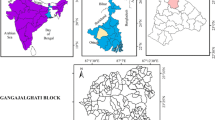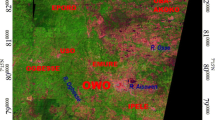Abstract
In the present study, the ground water prospect of Mysore district has been delineated using remotely sensing data, base map of GSI, ground truth data, and geographic information system. Based on these integrated studies, it has been noticed that the lithology of the area mainly represents by amphibolite schists, hornblende-biotite gneiss, chamockite, quartzite and granite belonging to Archean to Lower Proterozoic. Resent alluvial deposits mainly occur as valley fills. Major lineaments are mainly confined to valley regions. Structurally the erosional and depositional landforms are occurring as hills, ridges, weathered pediments, weathered pediplains and valley fills. Geonaorphology, lineaments, drainage density, type of lithology and surface water bodies are directly influencing the ground water conditions and it is very good iu valley regions and in remaining area, it is moderate to poor.
Similar content being viewed by others
References
Ganesha Raj, K. (1994). Major lineaments of Karnataka and their significance. Geo Karnataka MGD Centernary, pp. 303-313.
Geological Survey of India (1981). Geological mineralogical map of Karnataka and Goa.
Ghose, R. (1993). Remote sensing for analysis of ground water availability in an area with long unplanned mining history.J. Indian Soc. Remote Sensing,21(3): 119–126.
Jagannadha Rao, M., Kumar, S.J., Surya Prakasa Rao, B and Srinivas Rao, P. (2003). Geomorphology and landuse pattern of Visakha Patnam, Urban industrial area.J. Indian Soc. Remote Sensing,31(2): 119–128.
Karanth, K.R., Jaganathan, V., Prakash, V.S. and Saivasa, V. (1992). Pegmatites: A potential source for setting high yielding wells.J. Geol. Soci India,39(1): 77–81.
Kumar, A., Tomar, S. and Prasad, L.B. (1999). Analysis of fractured inferred from DBTM and remotely sensed data for groundwater development in Godavari sub-watershed, Giridih, Bihar.J. Indian Soc. Remote Sensing,26(2): 105–114.
Murthy, K.N. and Jayaram, K.M. (1996). Groundwater resources and development potential of Parbhani district, Maharastra, C.G.W.B Report on Annual Action Programme (1995–96). 702/DIS/196, Nagpur, pp.1–39.
NRSA (1995). Integrated Mission for Sustainable Development (IMSD)- Technical guidelines. National Remote Sensing Agency, Hyderabad.
NRSA (2000). Technical guidelines for preparation of Ground water prospect map, Rajiv Gandhi National Drinking Water Mission. National Remote Sensing Agency, Hyderabad.
Obi Reddy, G.P., Chandra Mouli, K., Srivastava, S.K. and Mali, A.K. (2000). Evaluation of ground water potential zones using remote sensing data- A case study of Gaimukh watershed, Bhandara district, Maharastra.J. Indian Soc. Remote Sensing,28(1): 19–32.
Pradeep, K.J. (1998). Remote sensing techniques to locate ground water potential zones in upper Urmil river basin District Chatarpur, Central India.J. Indian Soc. Remote Sensing,26(3): 135–147.
Pratap, K., Ravindran, K.V. and Prabhakaran, B. (2000). Ground water prospect zoning using remote sensing and geographical information system: A case study in Dala-Renukoot area, Sonbhadra district, Uttar Pradesh.J. Indian Soc. Remote Sensing,28(4): 249–263.
Ravindran, K.V. and Jeyram, A. (1997). Ground water prospects of Shahbad Teshil, Baran District, Eastern Rajasthan: A Remote Sensing Approach.J. Indian Soc. Remote Sensing,25(4): 239–246.
Sankar, K. (2002). Evaluation of Groundwater potential zones using remote sensing data in Upper Vaigai river basin, Tamilnadu India.J. Indian. Soc. Remote Sensing,30(3): 119–128.
Saraf, A.K. and Choudhary, P.R. (1998). Integrated remote sensing and GIS for ground water exploration and identification of artificial recharge sites.Int. J. Remote Sensing,19(10): 1825–1841.
Smith, K.G. (1950). Standards for grading texture of erosional topography.Am. Jr. Sci.,248: 655–668.
Srivastava, P.K. and Bhattacharya, A.K. (2000). Delineation of groundwater potential zones in a hard rock terrain of Bargah district, Orissa using IRS data.J. Indian Soc. Remote Sensing,28(2&3): 129–140
Strahlear, A.N. (1957). Quantitative analysis of watershed geomorphology.Trans. Am. Geophysics. Union,38: 913–920.
Subba Rao, N. (1992). Factors affecting optimum development of groundwater in crystalline terrain of the Eastern Ghats, Visakhapatnam area, Andhra Pradesh, India.J. Geol. Soci India,40(5): 462–467.
Thornbury, W.D. (1990). Principles of Geomorphology. Wiley Eastern Limited, New Delhi, 594P.
Author information
Authors and Affiliations
Corresponding author
About this article
Cite this article
Lokesha, N., Gopalakrishna, G.S., Gowda, H.H. et al. Delineation of ground water potential zones in a hard rock terrain of Mysore district, Karnataka using IRS data and GIS techniques. J Indian Soc Remote Sens 33, 405–412 (2005). https://doi.org/10.1007/BF02990011
Received:
Revised:
Issue Date:
DOI: https://doi.org/10.1007/BF02990011




